What could be more comfortable, warmer and more refined than a wooden floor? Modern market ...
|
|
A child from an early age needs a personal space where he would feel in ... |
For a decorative and protective coating of a wooden door, there is a large ... |
Septic Termit: Installation Instructions
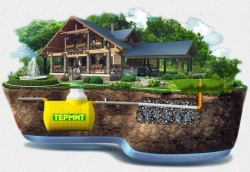
Modern cottage or country house is inconceivable without the usual amenities of a well -maintained bathroom, hot soul and washing machine. However, the central sewage system is not available in all corners of the suburbs, summer cottages and villages. To connect plumbing points in the house, an autonomous sewage system Septic Termite is used.
Consider the device and principle of operation of the local treatment plant, as well as describe the sequence of installation of the septic tank on the personal plot.
- Device and principle of operation septic tank termite
- Septic tank Termit: advantages and disadvantages of installation
- Modifications of the Termit septic tank
- Installation schemes of septic tank termite
- Rules for the installation of the Termit septic tank: regulatory documents and basic requirements
- Installation of septic tank Termit with your own hands
- Operation and maintenance of the treatment plant
Device and principle of operation septic tank termite
Septics are used to clean household waste. Local and treatment facilities are used in places where there is no central sewage system: cottages, country houses, cottages, etc. The Termit Autonomous Station provides maximum drain purification before they enter the soil.
The production of the Termit septic tank has been established in Russia, so the equipment meets all the requirements of Russian environmental, sanitary-epidemiological and construction standards. The termite is considered an analogue of the popular treatment plant Septic tank and is a direct competitor.
Septic tide is a visual example of the All-in system. The device is a whole tank divided into several sections. The system consists of two or three chambers, passing through which the drains are brightened and cleaned during mechanical/biological cleaning.
The main nodes of the Termit septic tank:
- Accumulative tank. Here, the primary cleaning of the solid particles occurs under the influence of gravity fall down to the bottom of the tank.
- Bacterial filter. Water cleaning is carried out using brushes on which bacteria colonies are located.
An overflow pipe is mounted in the septic tank case, which connects the device compartments. The termite uses energy -dependent treatment technology.
The principle of operation of the local cleaning system can be divided into the following stages:
- Stocks flow and accumulate in the first tank. At this stage, large particles are separated from small ones and precipitate.
- The passage to the next camera is located at such a level that the emerging fractions and sediment do not enter it and remain in the first compartment.
- In the last chamber of the accumulative tank, part of the drains under the influence of anaerobic bacteria decomposes, and rises to the surface of the compartment. Here, wastewater passes through the filtering element and is cleaned by 60-70%.
- The purified water enters the orphaning dome. Water from this compartment can be used to irrigate the garden/garden.
- Further cleaning of the ground dofiltration. There are many microorganisms in the soil that oxidize chemical compounds and make them sanitary safe. As a result of the operation of the septic tank and soil filtration, wastewater is cleaned by 95%.
Septic tank Termit: advantages and disadvantages of installation
The main advantages of the Termit septic tank include:
- autonomy and energy dependence of the installation;
- the stability of the treatment system for temperature fluctuations and soil pressure;
- a variety of modifications makes it possible to choose a model in accordance with the needs of a particular house and family;
- the design provides a powerful flushing filter that does not need to be replaced;
- seamless high -quality plastic housing ensures the strength and wear resistance of the septic tank;
- the treatment system can work immediately after the installation and connection of drainage/sewage pipes (some septic tanks begin to operate a few days after a few days is necessary for shrinkage of soil);
- high degree of wastewater treatment;
- saving cash on concreting housing and survey;
- the arrangement of the groundwater does not affect the arrangement of sewage;
- a long service life of about 50 years;
- available value of the budget option for septic tank termite will cost 24,000 rubles.
Despite the significant advantages, the termite septic tank is not devoid of some shortcomings:
- lack of deeply cleaning system and filters that eliminate smells;
- the body of the septic tank of a rectangular shape without rounded corners tension at the corners increases and the risk of bending the walls appears;
- some users note that, despite the thick walls of the case, the load on them is distributed unevenly in one place the thickness of the container can be 20 mm, and in the other 10 mm;
- the septic tank installation scheme has a fairly complex technology installation work to entrust it to professionals;
- each season it is necessary to clean the first gravitational compartment.
Modifications of the Termit septic tank
Manufacturers have developed several modifications of the termite septic tank.
Septic tank Termite 1F with a capacity of 0.35 cubic meters/day and a volume of 1.2 cubic meters. We apply 1-2 people for a small family. Plumbing devices can be connected to the device: two shells, a toilet, a shower cabin and washing/dishwasher. The cost of this model is about 19000 p.
Termite 1.5F Suitable for a family consisting of two adults and one child. Septic tank performance is about 0.5 cubic meters/day. The price of the termite of 1.5F is 23000 r.
Septic tank Termite 2F It has the following characteristics:
- the volume of the accumulative tank 2000 l;
- the thickness of the walls of the case is 15-20 mm;
- installation length 1.8 m, width 1.2 m, height with a neck of 2.05 m;
- the number of cameras 2;
- septic tank performance 0.7 cubic meters. per day;
- weight 140 kg;
- the device is designed for 2-4 people, the house is not more than 200 sq.m.;
- the septic tank is able to simultaneously serve: 2 toilets, 4 shells, washing machine, bath, shower and dishwasher;
- the septic tank includes a filter element consisting of synthetic fabric for a colony of bacteria, pumice and weighting agent (granite crumb);
- the price of the Termit 2F Termit is about 29000 p.
Characteristics of the septic tank Termit 3F:
- the number of cameras 3;
- the total volume of all cameras is 3000 liters;
- device dimensions: length 2.2 m, width 1.2 m, height with a neck of 2.04 m;
- the thickness of the case is 20 mm;
- weight septic tank 185 kg;
- material of the manufacturing of the housing rotational linear polyethylene;
- the presence of a filter element;
- septic tank performance 1.0-1.2 cubic meters.;
- suitable for a family of 4-6 people;
- able to serve all household items indicated in the previous list plus jacuzzi;
- the price of treatment equipment is 37000 p.
Septic tank Termite 5F Designed for 7-11 users, the volume of a storage tank 5.5 cubic meters. The model has a three -chamber design and is equipped with a filter element. Productivity during the day 2.4 cubic meters.
Installation schemes of septic tank termite
Installation of the Termit septic tank can be performed in several ways:
- For soils with normal absorption, the installation circuit using the orphanage dome is used. The volume of irrigation capacity depends on the performance of the septic tank.
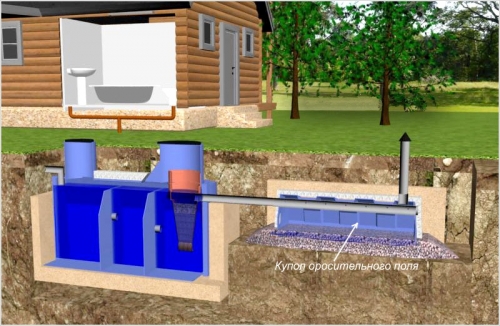
- Septic Termite Installation of the local treatment system using drainage pipes. The installation scheme is suitable for soils with the normal ability of absorption.

- For the conditions of sandy soil with a low arrangement of groundwater (less than 1.5 m), installation with a filtration well is used.
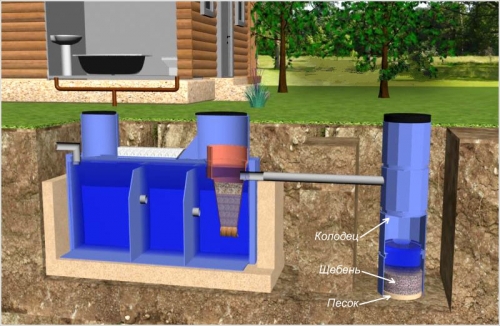
- The termite installation scheme with an intermediate well, drainage pump and check valve. In this case, installation in soils with a high level of groundwater is possible.
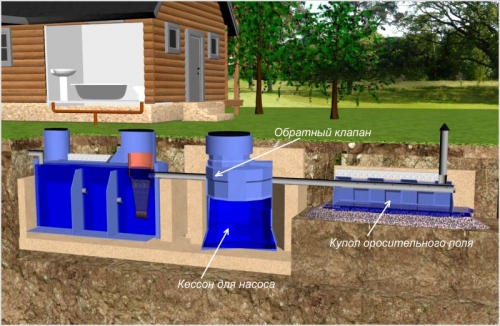
- With a stable high level of groundwater, the following installation of an autonomous installation is involved. The dome of the incriminating field is lifted just above the ground level and is insulated with a layer of soil.
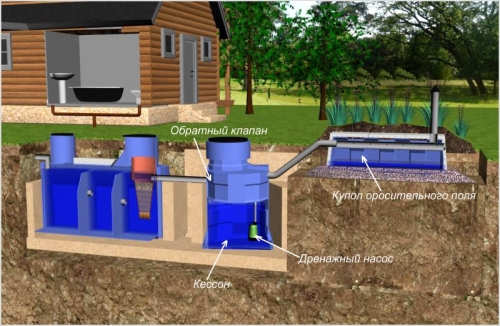
- With a high level of groundwater, a drainage pumping installation can be placed in a well.
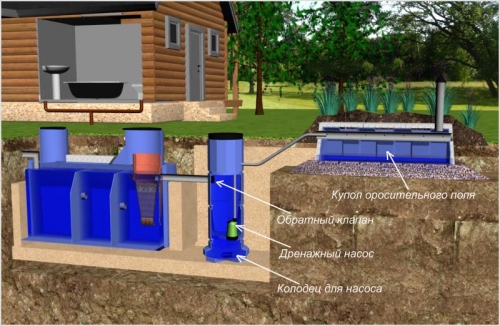
- Installation of the Termit septic tank in clay and other soils with a low absorption ability provides for the arrangement of a special filtration field. The filtration sector includes layers of sand and crushed stone. Passing through the filtration field, purified water flows into the drainage well, and then into the relief.
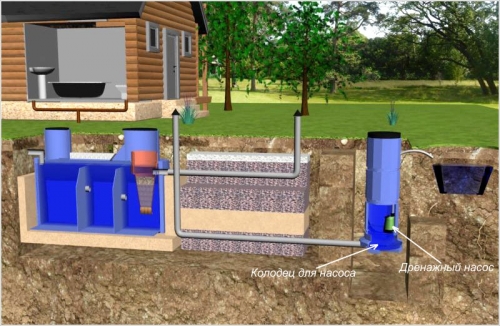
Rules for the installation of the Termit septic tank: regulatory documents and basic requirements
The septic tank carries a potential danger to nature, so the uncontrolled installation of such a device is prohibited. Before starting the installation of the local treatment system, you need to draw up a working project, approve the document in the SES and get permission to use the septic tank.
Important! The permit for the installation of a septic tank can only be obtained if the project complies with all existing sanitary and construction standards. The main attention when checking the project by experts pay the placement of the treatment plant
The main requirements for the installation of the septic tank are set forth in regulatory documents:
- SNiP No. 2.04.03-85 regulates the construction of external sewer structures and networks;
- SNiP No. 2.04.04-84/SNiP No. 2.04.01-85 describes the procedure for arranging construction internal/external water supply networks (the document must be taken into account if the house is carried out through the well/well);
- sanitary norms (SanPiN 2.1.5.980-00, SanPiN 2.2.1/2.1.1.1200-03) The documents formulated the main requirements for the creation of sanitary protection zones around potentially dangerous points for the environment.
Septic tank arrangement rules:
- It is very important to prevent drains from entering the aquifers, is a serious threat to infectious diseases. Of course, the termite of the termite is sealed, but it is impossible to completely exclude the emergence of an emergency. The distance between the septic tank and the well/well should be as large as possible:
- the minimum distance of 20 m, provided there is no connection between the soil revised for the filtration of wastewater, and water -bearing layers;
- in areas with loamy, sand and sandy soils, the distance from the septic tank to the water well should be 50-80 m;
- the pipes on which drinking water arrives should be laid at a distance of at least 10 m from the treatment plant.
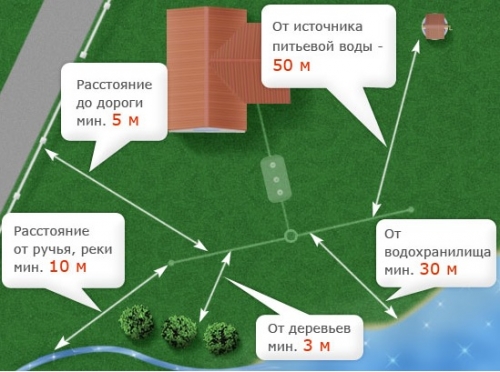
- Requirements for the distance between the residential building and the Termit septic tank:
- from the foundation of the house to a treatment device at least 5 m;
- when placing a septic tank, it is not necessary to retreat too much distance so difficult to ensure the strength and uninterrupted operation of the pipeline;
- on a long pipeline every 15 m and in the turns of rotation, the installation of an audit well is required.
- From the roadway to the treatment plant should be at least 5 m.
- The distance between the septic tank and the fence separating neighboring areas is at least 2 m.
- The distance to the construction buildings is not less than 1 m.
- The treatment with the sewer must be provided for free passage of assenced technology.
Installation of septic tank Termit with your own hands
Possessing skills in construction and observing the recommendations of the manufacturer, you can install the Termit septic tank with your own hands.
For installation work will be needed:
- pipe with a diameter of 110 mm;
- material for thermal insulation of pipes;
- drainage pipe;
- sand and cement;
- fitting.
Septic installation sequence:
- Inspect the septic tank capacity. There should be no dents, cracks and other damage on the case.
- Dig a pit under a septic tank and a trench for laying sewer pipes. It is advisable to attract special equipment for work. The width of the pit should be larger than the septic tank with 20-30 cm. The trench for a supply pipe is dug with a slope - 2 cm per 1 linear meter.
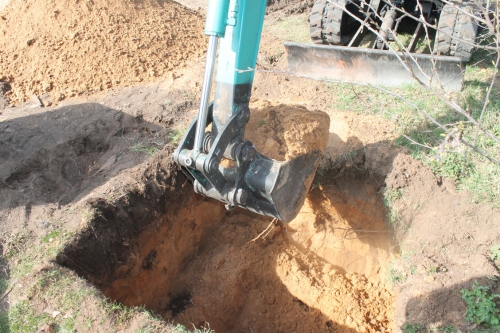
- To align the walls and bottom of the pit.
- The bottom of the pit under the septic tank sprinkle with sand the thickness of the sand pillow 3-5 cm. The permissible deviation of the bottom of the septic tank from the base of the pit is not more than 1 cm per 1 linear meter.
- The bottom of the pit for the irriger fill with gravel the thickness of the layer about 40 cm.
- Pour the bottom of the pipeline trenches with sand 20-30 cm.
- In the trench, lay a diveting pipe with a minimum slope of 1 cm per 1 linear meter. It is advisable to insulate the pipe with heat -insulating material.
- Using a special lifting technique, immerse the septic tank in the pit.
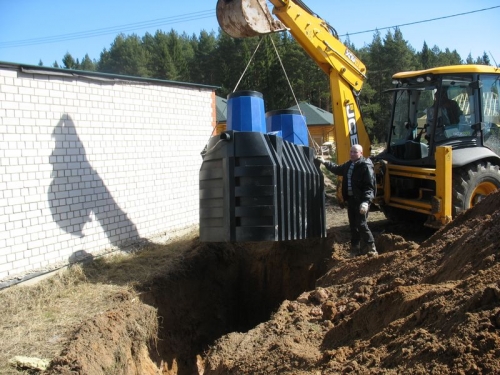
- Mix sand with cement in the ratio of 5: 1 and perform the backfill of the septic tank. Every 20 cm cement-sand mixture must be rammed. Work to reach the level of soil.
- Simultaneously with the backfill of the septic tank, the septic tank should be exceeded evenly with water. The water level should be ahead of the backfill of 20-30 cm.
- Mount the filtration element, connect the sewage and drainage to the nozzles. Hermetic process connecting seams.
Important! Reverse filling of the Termit septic tank is carried out exclusively by hand without the use of construction equipment
Installation Septic tank Termit: Video
Operation and maintenance of the treatment plant
In order for the Termit septic tank to serve as long as possible to properly and timely care for the device:
- during operation, it is advisable to use special biobacteria preparations, they accelerate the decomposition of waste and improve the work of the septic tank;
- cleaning the sewer system from sludge to perform every 1-2 years;
- periodically, you need to mix granules with bacteria.

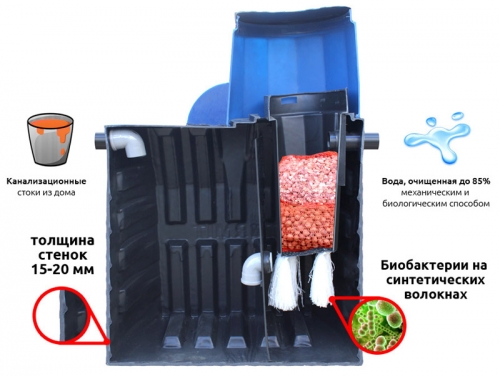
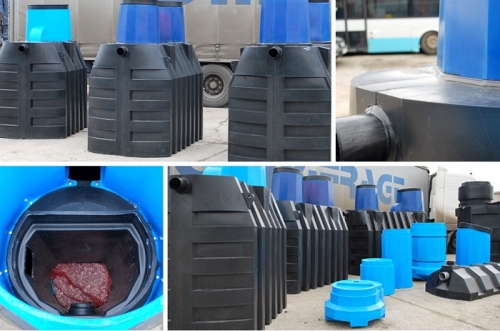
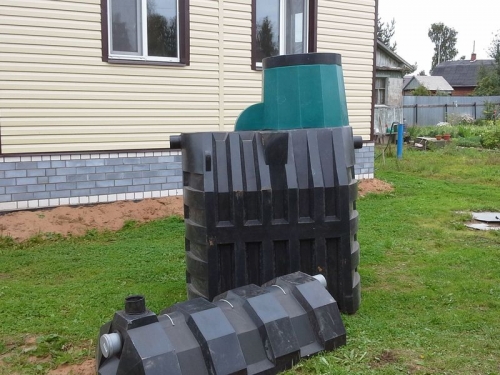
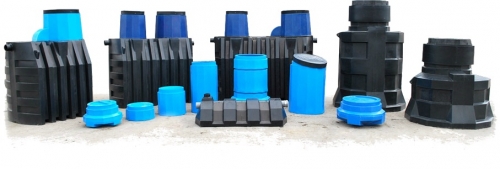
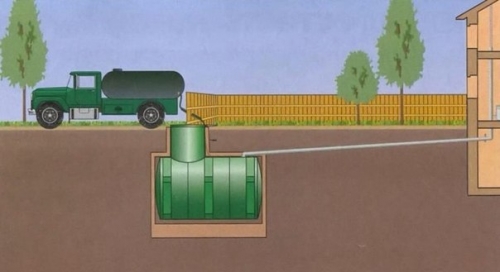
Septic termite Poor fake
Septic Termite is a bad fake for the septic tank known to the whole of Russia.
For example, Tank 2.5 and Termit 2.5 declared 1000 liters per day. Only at the termite 2.5, the working volume does not correspond to the number in the name, unlike the tank, and this is despite the fact that the price of the termite costs for the number 2.5 of which is not in fact, but the client pays for the half of the cube of air.
How can they be the same in size and price?
The universal-2.5 tank costs 30,000 rubles and has dimensions 2200x1200x1850
In size, it corresponds to the Termit Standard-3.5 for 41800 rubles and the termit-prof-3.5 worth 53,700 rubles with the same as the tank-universal-2.5 dimensions.
The difference in price for the same in actual volume of the case do you not notice any? For example, in the tank, the number-2.5 in fact corresponds to 3.5 of them? The difference in price is 11800 and 23,700 rubles compared to the cost of the tank either?
In fact, people do not understand what they pay for, for example, paying for the termit-prof-3.5 53700 rubles, they will receive what the Triton is called the UNIVIVERSAL-2.5 tank and it costs only 30,000 rubles, while the body is the same in volume.
A good attempt by Triton, but
A good attempt by Triton, but no! That the tank, that the termite is septic tanks that are inconvenient to serve and which require soil treatment. Take any moose analogue of the topas and you will not know troubles. They actually clean the drains up to 98%. It is better to pay once and not remember anymore.